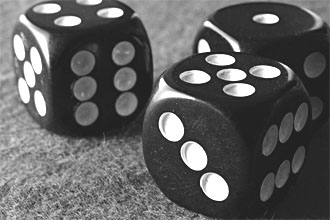|
| Magriel's NYT Columns |
 The Black and White Chicago Classic Backgammon Tournament, held earlier this month drew a strong field that included several of Europe’s top players. The surprise winner was Barbara Glazer of Kansas City, a comparative newcomer to tournament play.
The Black and White Chicago Classic Backgammon Tournament, held earlier this month drew a strong field that included several of Europe’s top players. The surprise winner was Barbara Glazer of Kansas City, a comparative newcomer to tournament play.
Her path to victory was not easy. In the first round she upset Arthur Dickman, Florida’s ranking player. After four more victories, she defeated Paul Magriel in the semifinals, then Roger Low of New York, the young international champion, in the finals.
In other sections: Robert Holyon overcame Joseph Suzyn to win the consolations; Kit Woolsey took the last chance; and Marilyn Turner beat Joanne Goulding in the intermediate.
The diagrammed position shows a key turning point in the 21-point finals match. Low (White) had begun the match by rolling well, and established a 10–5 lead. In this game, Mrs. Glazer (Black) had already doubled but now found herself in an awkward position. Despite her lead in the race, she would have great difficulty coming home safely: Low had managed to create a favorable holding position that left her stranded with two outfield points (the 11 and 13). To compound her difficulties, she rolled a 5-1, which forced her to leave a man open and so give White an immediate shot.
|
10
MATCH TO 21 5 |
| Black to play 5-1. |
Mrs. Glazer, however, calmly studied the position and found a superior alternative. She correctly played 11/6, 11/10, unflinchingly leaving a man exposed on the 10-point to a double direct shot, 5’s and 3’s (25 chances out of 36).
|
|
|
In the actual game, Low missed the double shot and Mrs. Glazer was fortunate; she came home safely without leaving any additional shots. After winning this game her luck held and Low scored only three more points for the rest of the match — the final score: 21–13.
Rollout
 Tom Keith 2013 |
|
Match to 21 White 10, Black 5 White owns 2-cube Black rolls 5-1 1296 games with VR Checker play: 2-ply Cube play: 3-ply Red |
| 5-1: | Game | G | BG | Equity | ||||
| 1 | 11/10, 11/6 |
W L |
.5741 .4259 |
.1935 .0681 |
.0034 .0023 | +0.1917 |

| (b) |
| 5 | 6/1, 3/2 |
W L |
.5202 .4798 |
.1661 .1305 |
.0026 .0040 | −0.0068 | (0.1985) | (a) |

|
|

